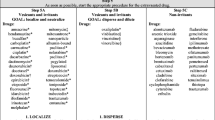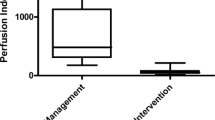Abstract
Extravasation of chemotherapy is a feared complication of anticancer therapy. The accidental leakage of cytostatic agents into the perivascular tissues may have devastating short-term and long-term consequences for patients. In recent years, the increased focus on chemotherapy extravasation has led to the development of international guidelines that have proven useful tools in daily clinical practice. Moreover, the tissue destruction in one of the most dreaded types of extravasation (ie, anthracycline extravasation) now can effectively be prevented with a specific antidote, dexrazoxane.
Similar content being viewed by others
References
Papers of particular interest, published recently, have been highlighted as: • Of importance•• Of major importance
Schrijvers DL: Extravasation: a dreaded complication of chemotherapy. Ann Oncol 2003, 14(Suppl 3):iii26–iii30.
Lemmers N, Gels M, Sleijfer D, et al.: Complications of venous access ports in 132 patients with disseminated testicular cancer treated with polychemotherapy. J Clin Oncol 1996, 14:2916–2922.
Shetty PC, Mody MK, Kastan DJ: Outcome of 350 implanted chest ports placed by interventional radiologists. J Vasc Interv Radiol 1997, 8:991–995.
• Schulmeister L: Extravasation management. Semin Oncol Nurs 2007, 23:184–190. This is an excellent overview, especially for the treating staff.
Larson DL: Treatment of tissue extravasation by antitumor agents. Cancer 1982, 49:1796–1799.
Seyfer AE, Solimando DAJ: Toxic lesions of the hand associated with chemotherapy. J Hand Surg [Am] 1983, 8:39–42.
•• Wengström Y, Margulies A; European Oncology Nursing Society Task Force: European Oncology Nursing Society extravasation guidelines. Eur J Oncol Nurs 2008,12:357–361. This is an overview of the updated European Oncology Nursing Society guidelines.
•• Polovich M, Whitford JM, Olsen M: Chemotherapy and Biotherapy Guidelines and Recommendations for Practice, edn 3. Pittsburg, PA: Oncology Nursing Society; 2009. These are important, updated guidelines for the handling of chemotherapy.
Berghammer P, Pohnl R, Baur M, Dittrich C: Docetaxel extravasation. Support Care Cancer 2001, 9:131–134.
Pitkänen J, Asko-Seljavaara S, Gröhn P, et al.: Adriamycin extravasation: surgical treatment and possible prevention of skin and soft-tissue injuries. J Surg Oncol 1983, 23:259–262.
Larson DL: What is the appropriate management of tissue extravasation by antitumor agents? Plast Reconstr Surg 1985, 75:397–402.
Preuss P, Partoft S: Cytostatic extravasations. Ann Plast Surg 1987,19:323–329.
Loth TS, Eversmann WWJ: Extravasation injuries in the upper extremity. Clin Orthop Relat Res 1991, 248–254.
Heitmann C, Durmus C, Ingianni G: Surgical management after doxorubicin and epirubicin extravasation. J Hand Surg [Br] 1998, 23:666–668.
Langstein HN, Duman H, Seelig D, et al.: Retrospective study of the management of chemotherapeutic extravasation injury. Ann Plast Surg 2002, 49:369–374.
Dahlstrøm, KK, Chenoufi HL, Daugaard S: Fluorescence microscopic demonstration and demarcation of doxorubicin extravasation. Experimental and clinical studies. Cancer 1990, 65:1722–1726.
Andersson AP, Dahlstrøm KK: Clinical results after doxorubicin extravasation treated with excision guided by fluorescence microscopy. Eur J Cancer 1993, 29A:1712–1714.
Gault DT: Extravasation injuries.Br J Plast Surg 1993, 46:91–96.
Barlock AL, Howser DM, Hubbard SM: Nursing management of adriamycin extravasation. Am J Nurs 1979, 79:94–96.
Harwood K, Gonin R: Long term vs long term cooling after doxorubicin (DOX) extravasation: An Eastern Cooperative Group (ECOG) study [abstract]. Proc ASCO 1994, 13:447.
Lawrence HJ, Goodnight SHJ: Dimethyl sulfoxide and extravasation of anthracycline agents. Ann Intern Med 1983, 98:1025.
Ludwig CU, Stoll HR, Obrist R, et al.: Prevention of cytotoxic drug induced skin ulcers with dimethyl sulfoxide (DMSO) and alpha-tocopherole. Eur J Cancer Clin Oncol 1987, 23:327–329.
Olver IN, Aisner J, Hament A, et al.: A prospective study of topical dimethyl sulfoxide for treating anthracycline extravasation. J Clin Oncol 1988, 6:1732–1735.
Lawrence HJ, Walsh D, Zapotowski KA, et al.: Topical dimethylsulfoxide may prevent tissue damage from anthracycline extravasation. Cancer Chemother Pharmacol 1989, 23:316–318.
Bertelli G, Gozza A, Forno GB, et al.: Topical dimethylsulfoxide for the prevention of soft tissue injury after extravasation of vesicant cytotoxic drugs: a prospective clinical study. J Clin Oncol 1995, 13:2851–2855.
Tsavaris NB, Komitsopoulou P, Karagiaouris P, et al.: Prevention of tissue necrosis due to accidental extravasation of cytostatic drugs by a conservative approach. Cancer Chemother Pharmacol 1992, 30:330–333.
•• Langer SW, Sehested M, Jensen PB: Anthracycline extravasation: A comprehensive review of experimental and clinical treatments. Tumori 2009, 5:273–282. This is a comprehensive and critical review of experimental and clinical studies of anthracycline extravasation.
Langer SW, Sehested M, Jensen PB: Treatment of anthracycline extravasation with dexrazoxane. Clin Cancer Res 2000, 6:3680–3686.
Langer SW, Sehested M, Jensen PB: Dexrazoxane is a potent and specific inhibitor of anthracycline induced subcutaneous lesions in mice. Ann Oncol 2001, 12:405–410.
Langer SW, Thougaard AV, Sehested M, et al.: Treatment of anthracycline extravasation in mice with dexrazoxane with or without DMSO and hydrocortisone. Cancer Chemother Pharmacol 2006, 57:125–128.
•• Thougaard AV, Langer SW, Hainau B, et al.: A murine experimental anthracycline extravasation model: pathology and study of the involvement of topoisomerase II alpha and iron in the mechanism of tissue damage. Toxicology 2010, 269:67–72. These are the most recent experimental studies of mechanism of action of the antidotal effect of dexrazoxane in anthracycline extravasation.
•• Mouridsen HT, Langer SW, Buter J, et al.: Treatment of anthracycline extravasation with Savene (dexrazoxane): results from two prospective clinical multicentre studies. Ann Oncol 2007, 18:546–550. Results from two multicenter clinical studies are provided, showing that dexrazoxane is highly effective in protecting against tissue destruction in biopsy-verified anthracycline extravasations.
Mouridsen HT, Langer SW, Tjoernelund J, et al.: Anthracycline extravasation in breast cancer patients. Effective treatment with dexrazoxane in three multicenter trials [abstract]. Eur J Cancer (Suppl) 2008, 6:197.
Langer SW: Treatment of anthracycline extravasation from centrally inserted venous catheters. Oncol Rev 2008, 2:115–117.
Hünerlitürkoglou AN, Tapprich C, Langer SW, et al.: Successful use of dexrazoxane in two cases of anthracycline containing polychemotherapy. Eur J Clin Med Oncology 2009, 1:13–15.
Aizawa H, Tagami H: Delayed tissue necrosis due to mitomycin C. Acta Derm Venereol 1987, 67:364–366.
Patel JS, Krusa M: Distant and delayed mitomycin C extravasation. Pharmacotherapy 1999, 19:1002–1005.
Murakami Y, Shibata S, Koso S, et al.: Delayed tissue necrosis associated with mitomycin-C administration. J Dermatol 2000, 27:413–415.
Theman TA, Hartzell TL, Sinha I, et al.: Recognition of a new chemotherapeutic vesicant: trabectedin (ecteinascidin-743) extravasation with skin and soft tissue damage. J Clin Oncol 2009, 27:e198–e200.
Owen OE, Dellatorre DL, Van Scott EJ, et al.: Accidental intramuscular injection of mechlorethamine. Cancer 1980, 45:2225–2226.
Raymond E, Cartier S, Canuel C et al.: Extravasation of paclitaxel (Taxol). Rev Med Interne 1995, 16:141–144.
Ascherman JA, Knowles SL, Attkiss K: Docetaxel (Taxotere) extravasation: a report of five cases with treatment recommendations. Ann Plast Surg 2000, 4:438–441.
Dorr RT, Snead K, Liddil JD: Skin ulceration potential of paclitaxel in a mouse skin model in vivo. Cancer 1996, 78:152–156.
Disclosure
Dr. Langer is a consultant for TopoTarget A/S.
Author information
Authors and Affiliations
Corresponding author
Rights and permissions
About this article
Cite this article
Langer, S.W. Extravasation of Chemotherapy. Curr Oncol Rep 12, 242–246 (2010). https://doi.org/10.1007/s11912-010-0110-7
Published:
Issue Date:
DOI: https://doi.org/10.1007/s11912-010-0110-7




